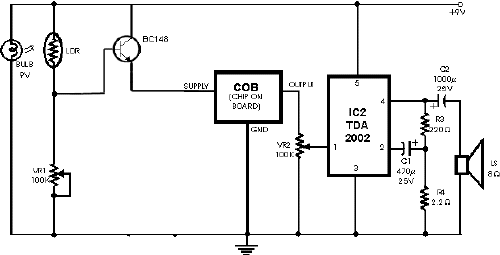Fire Alarm
This circuit warns the user against fire accidents. It relies on the smoke
that is produced in the event of a fire. When this smoke passes between a bulb
and an LDR, the amount of light falling on the LDR decreases. This causes the
resistance of LDR to increase and the voltage at the base of the transistor is
pulled high due to which the supply to the COB (chip-on-board) is completed.
Different COBs are available in the market to generate different sounds.
The choice of the COB depends on the user. The signal generated by COB is
amplified by an audio amplifier. In this circuit, the audio power amplifier is
wired around IC TDA 2002. The sensitivity of the circuit depends on the distance
between bulb and LDR as well as setting of preset VR1. Thus by placing the bulb
and the LDR at appropriate distances, one may vary preset VR1 to get optimum
sensitivity.
An ON/OFF switch is suggested to turn the circuit on and off as desirable.
Title: Fire Alarm
electronic circuit
Source: www.electronic-circuits-diagrams.com
Published on: 2005-02-01
Reads: 1356
Print version: ![]()
Other electronic circuits and schematics from Security and other sensors and detectors
-
Field-strength meter
-
Voice activated switch
-
Mains Remote-Alert
-
IR Remote Control Extender Circuit
-
Remote Doorbell Warning Switch
-
Rain Alarm
-
Fridge door Alarm
-
Live-line Detector
-
Electronics Telephone Talking Circuit
-
Metal Detector

